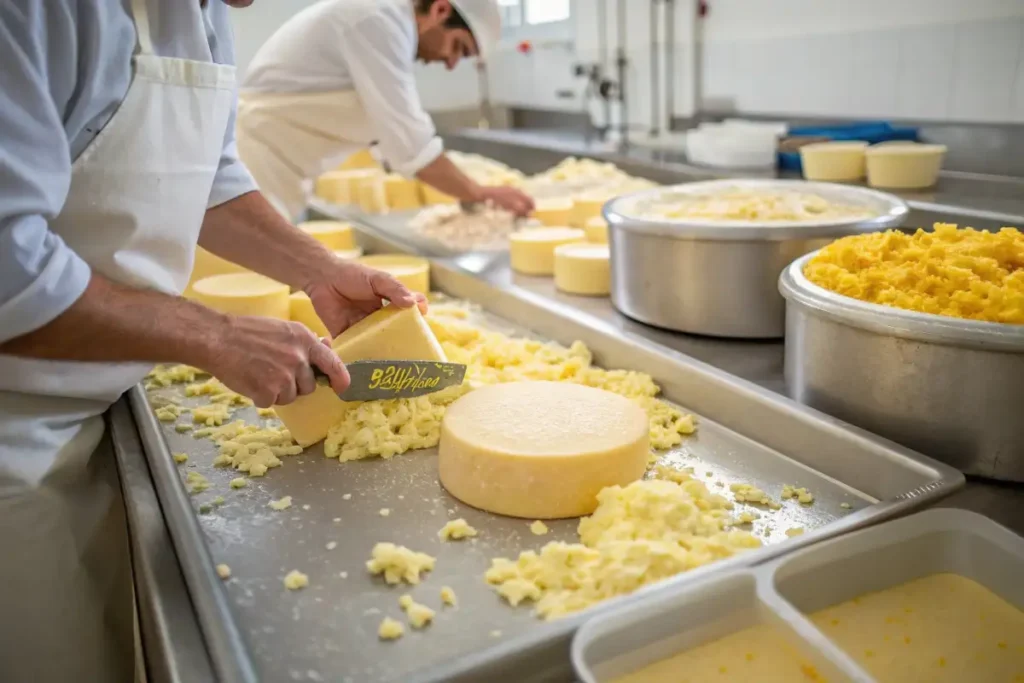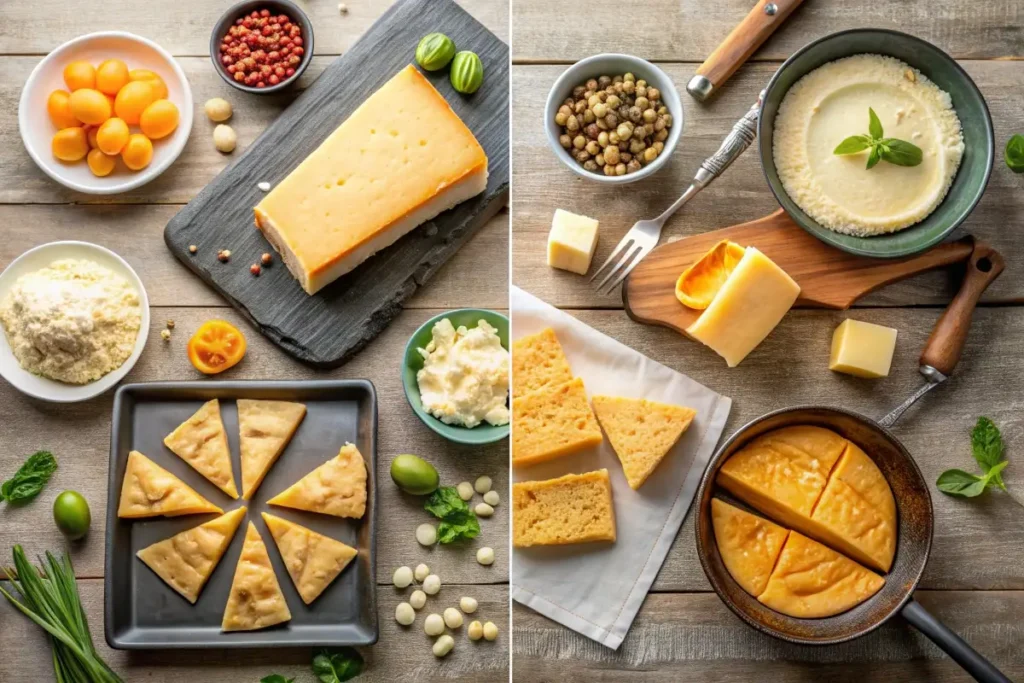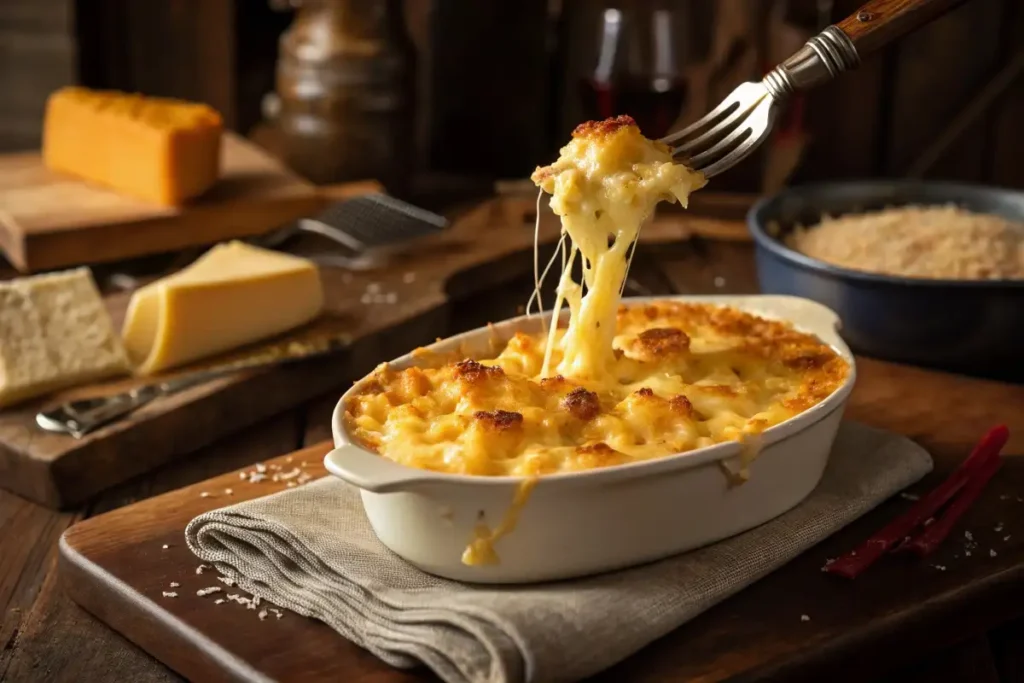Cheddar cheese is one of the most beloved cheeses in the world. Whether you enjoy cheddar melted over a burger, sliced in a sandwich, or paired with a glass of wine, this rich, tangy dairy product has captivated cheese lovers for centuries. But how much do you really know about this iconic cheese?
In this article, we’ll explore everything about cheddar—its origins, how it’s made, different varieties, health benefits, and even the best ways to cook with it. You’ll also learn how to store it properly to keep it fresh and flavorful for longer.
Ready to dive into the world of cheddar cheese? Let’s start with a brief introduction to this delicious dairy classic.
Introduction to Cheddar Cheese
Origins of Cheddar Cheese
Cheddar cheese traces its roots back to the small village of Cheddar in Somerset, England, where it was first produced over 800 years ago. Legend has it that a milkmaid accidentally left a pail of milk in a cave, and when she returned, it had transformed into a hard, flavorful cheese. Over time, cheese-making techniques improved, leading to the classic cheddar cheese we know today.
Definition and Characteristics
Cheddar is a firm, cow’s milk cheese known for its smooth texture and nutty, sharp taste. The flavor of this cheese varies depending on how long it has been aged—mild versions are creamy and soft, while aged varieties develop a stronger, more complex profile with a slightly crumbly texture.
One interesting feature of cheddar is its color variation. Natural cheddar is white or pale yellow, but many producers dye it orange using annatto, a natural coloring derived from seeds. This doesn’t change the taste—it’s purely for aesthetics.
Whether it’s mild or extra sharp, this cheese remains a favorite choice for countless recipes. Now that you know what makes it special, let’s explore its fascinating history.
The History of Cheddar Cheese
Early Beginnings in Somerset, England
Cheddar’s story begins in Somerset, England, during the 12th century. Farmers in the village of Cheddar discovered that aging cheese in cool, damp caves created a firmer texture and richer taste. Over time, the technique spread, and this variety became a staple across England.
By the 17th century, cheddar was already famous throughout Britain. Large-scale production started, and cheesemakers refined the process, making it more consistent and widely available. Despite its humble beginnings, it quickly gained popularity beyond England’s borders.
Joseph Harding and Modern Cheesemaking
Fast forward to the 19th century, and one name stands out—Joseph Harding. Known as the “Father of Modern Cheddar”, he revolutionized production by introducing scientific methods that improved hygiene, consistency, and aging.
He also promoted the use of a technique called cheddaring, which gives the cheese its firm, crumbly texture. Harding’s influence spread worldwide, particularly to the United States, Canada, and Australia, where cheddar-making flourished.
Global Spread and Popularity
With advancements in transportation and refrigeration, cheddar cheese became a global favorite. In the 20th century, mass production made it one of the most widely consumed cheeses in the world. Today, the U.S. alone produces over 3 billion pounds of cheddar cheese each year, making it one of the most popular cheeses in America.
From a small village in England to grocery stores and kitchens worldwide, cheddar cheese has truly stood the test of time. But what makes it unique? Let’s explore the cheddaring process in the next section.
The Cheddaring Process: How Cheddar Cheese is Made

Milk Selection and Preparation
Every great cheddar cheese starts with high-quality cow’s milk. Most cheesemakers use pasteurized milk, but some traditional cheddars, like farmhouse cheddar, are made with raw milk for a richer taste.
The process begins by warming the milk and adding bacterial cultures. These cultures help develop cheddar cheese’s signature tangy flavor. Next, rennet, a natural enzyme, is added to help the milk coagulate and form solid curds.
Coagulation and Curd Formation
Once the rennet works its magic, the milk turns into a soft, jelly-like mass. Cheesemakers then cut it into small curds, which are gently stirred and heated. This process removes whey, the liquid part of milk, concentrating the curds.
At this stage, the curds start to firm up. The more whey is drained, the denser the cheese will be. This is why cheddar cheese has a firmer texture than many soft cheeses like mozzarella or brie.
The Unique Cheddaring Technique
Here’s where cheddar cheese gets its name! Unlike other cheeses, cheddar goes through a process called cheddaring.
During cheddaring, the curds are stacked in layers, pressed together, and flipped regularly. This removes even more whey and helps develop a firmer structure. The curds are then cut into strips, salted, and pressed into molds, forming the classic cheese blocks we recognize.
Aging and Maturation
Once shaped, cheddar cheese is left to age—sometimes for just a few months, other times for several years. The longer it ages, the sharper and more crumbly it becomes.
- Mild cheddar ages for 2-3 months, staying creamy and smooth.
- Sharp cheddar is aged for 6-12 months, developing a bolder taste.
- Extra sharp cheddar can mature for over 2 years, forming tiny, crunchy crystals inside.
Aging takes place in cool, humidity-controlled environments, sometimes in caves, just like the original cheddars from Somerset.
Now that we’ve uncovered how cheddar cheese is made, let’s look at the many varieties available in the next section.
Varieties of Cheddar Cheese

Mild, Medium, Sharp, and Extra Sharp Cheddars
Cheddar cheese comes in different levels of sharpness, which depend on how long it’s aged. Mild cheddar is aged for about 3 to 6 months, giving it a smooth and creamy taste. Medium cheddar is aged a bit longer, around 6 to 9 months, developing a richer flavor. Sharp cheddar, aged 9 to 12 months, has a more pronounced, tangy taste. Extra sharp cheddar is aged over a year, offering a bold and crumbly experience.
White vs. Orange Cheddar: What’s the Difference?
You might have noticed that cheddar cheese can be white or orange. The difference is simply due to coloring. Natural cheddar is white or pale yellow. To achieve the orange hue, cheesemakers add annatto, a natural coloring from seeds. This doesn’t change the flavor; it’s just for appearance. So, whether you choose white or orange cheddar, the taste remains the same.
Flavored Cheddars: Innovations and Trends
Cheesemakers often experiment by adding flavors to traditional cheddar. You can find cheddars infused with herbs like garlic and chives, spices such as chipotle or jalapeño, and even sweet additions like cranberries or apple cinnamon. These flavored cheddars offer a delightful twist, catering to diverse palates and culinary uses.
For more delicious recipes, check out our recipe article.
Nutritional Profile and Health Benefits of Cheddar Cheese
Macronutrient Composition
Cheddar cheese is a nutrient-dense food. A one-ounce (28-gram) serving provides approximately 114 calories, 9.4 grams of fat, 7 grams of protein, and minimal carbohydrates. The high protein content makes it a satisfying snack, while the fats contribute to its rich flavor and creamy texture.
Vitamins and Minerals in Cheddar
Beyond macronutrients, cheddar cheese is rich in essential vitamins and minerals. It’s an excellent source of calcium, offering about 200 milligrams per ounce, which supports bone health. Additionally, it provides vitamin A, phosphorus, and zinc, all vital for various bodily functions.
Potential Health Benefits and Considerations
Including cheddar cheese in your diet can offer several health benefits. The high calcium content supports strong bones and teeth. The protein aids in muscle repair and growth. However, it’s essential to consume cheddar in moderation due to its saturated fat and sodium content, which, in excess, can contribute to heart disease and high blood pressure. Opting for aged cheddars can be beneficial for those sensitive to lactose, as the aging process reduces lactose levels.
Incorporating cheddar cheese into a balanced diet can enhance both flavor and nutrition. As with all foods, moderation is key to enjoying its benefits while minimizing potential drawbacks.
Cooking and Pairing with Cheddar Cheese

Popular Culinary Uses of Cheddar
Cheddar is one of the most versatile cheeses in cooking. Whether melted, shredded, or sliced, it adds a rich, creamy texture and a sharp, tangy flavor to a variety of dishes.
- Mac and cheese: The ultimate comfort food, made even better with aged varieties.
- Grilled cheese sandwich: Melts perfectly, creating a gooey, crispy bite.
- Cheeseburgers: A classic topping that enhances the smoky, juicy taste of beef.
- Cheddar biscuits: Buttery and flaky, packed with cheesy goodness.
- Soups and sauces: Adds depth and creaminess to dishes like broccoli-cheese soup or nacho sauce.
Mild cheddar melts smoothly, while sharp varieties provide a stronger, bolder taste. Whether you’re baking, grilling, or cooking, this classic cheese takes dishes to the next level.
Pairing Cheddar with Beverages and Foods
Pairing cheddar cheese with the right food or drink can enhance its flavors. Here’s what works best:
- Wine: Aged cheddars pair well with bold red wines like Cabernet Sauvignon. Mild cheddars go great with crisp white wines like Chardonnay.
- Beer: Try a sharp cheddar with a hoppy IPA or a mild cheddar with a smooth lager.
- Fruits: Apples, pears, and grapes bring out cheddar’s nutty, tangy notes.
- Crackers and bread: Serve cheddar with whole-grain crackers or crusty bread for a delicious snack.
With so many pairing possibilities, cheddar cheese can fit into almost any meal or occasion.
Storage Tips to Maintain Freshness
To keep cheddar cheese fresh and flavorful, store it properly:
- Wrap it in wax paper or parchment paper first, then cover it with plastic wrap to let it breathe while preventing drying.
- Keep it in the cheese drawer or vegetable crisper of the fridge to maintain moisture.
- Avoid storing it near strong-smelling foods, as cheddar cheese can absorb odors.
If stored well, cheddar cheese can last for weeks, ensuring you always have a delicious ingredient ready to use.
FAQs
Cheddar cheese has both nutritional benefits and potential downsides depending on how it’s consumed. On the positive side, it is high in protein and calcium, which support bone health, muscle function, and overall well-being. Aged cheddar also contains less lactose, making it easier to digest for some people.
However, cheddar is also rich in saturated fat and sodium, which, when consumed excessively, may contribute to heart disease and high blood pressure. The key is moderation—enjoying it as part of a balanced diet can provide its benefits while minimizing health risks.
There are two main types of cheddar:
White Cheddar – This is the natural form of cheddar without any added coloring. It has a pale yellow or off-white appearance and the same taste as its colored counterpart.
Orange Cheddar – This version is colored using annatto, a natural dye from achiote seeds. The color does not affect the flavor, but it adds a distinct visual appeal.
Both types have similar texture and taste, with aging time being the biggest factor in flavor differences.
Unlike some cheeses that have a Protected Designation of Origin (PDO), cheddar is produced worldwide, making it difficult to restrict its name to one region. However, “West Country Farmhouse Cheddar” from England is PDO-certified, meaning it must be made in specific counties using traditional methods.
Because cheddar-style cheeses are made globally, the name itself is not protected, allowing variations to be produced in different countries.
There are several reasons why cheddar is such a beloved cheese:
Aging Process: As it matures, it develops richer, sharper, and more complex flavors with nutty and tangy notes.
Perfect Texture: Whether melted, shredded, or sliced, it has a creamy yet firm consistency that makes it versatile.
Works with Many Dishes: From burgers and mac & cheese to sandwiches and wine pairings, cheddar enhances a variety of foods.
With its bold taste and smooth texture, cheddar continues to be a favorite choice for cheese lovers worldwide.
Conclusion
From its humble beginnings in Somerset, England, to becoming a staple in kitchens worldwide, cheddar cheese has truly stood the test of time. Its rich history, unique aging process, and incredible versatility make it a favorite among cheese lovers everywhere. Whether you prefer it mild and creamy or extra sharp and crumbly, there’s a cheddar for every taste.
Beyond its delicious flavor, cheddar cheese also packs a nutritional punch, offering protein, calcium, and essential vitamins. And when it comes to cooking, it’s hard to beat—melting beautifully into mac and cheese, adding a bold kick to burgers, or pairing perfectly with wine and fruit on a charcuterie board.
No matter how you enjoy it, cheddar cheese remains a symbol of comfort, quality, and tradition. So next time you’re at the grocery store, why not try a new variety or experiment with a new recipe? One thing’s for sure—life is always better with a little cheddar cheese! 🧀🔥


7 thoughts on “Cheddar Cheese: Why It’s Loved, Health Benefits & Best Uses”